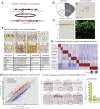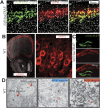Layer 2/3 pyramidal cells in the medial prefrontal cortex moderate stress induced depressive behaviors
- PMID: 26371510
- PMCID: PMC4566133
- DOI: 10.7554/eLife.08752
Layer 2/3 pyramidal cells in the medial prefrontal cortex moderate stress induced depressive behaviors
Abstract
Major depressive disorder (MDD) is a prevalent illness that can be precipitated by acute or chronic stress. Studies of patients with Wolfram syndrome and carriers have identified Wfs1 mutations as causative for MDD. The medial prefrontal cortex (mPFC) is known to be involved in depression and behavioral resilience, although the cell types and circuits in the mPFC that moderate depressive behaviors in response to stress have not been determined. Here, we report that deletion of Wfs1 from layer 2/3 pyramidal cells impairs the ability of the mPFC to suppress stress-induced depressive behaviors, and results in hyperactivation of the hypothalamic-pituitary-adrenal axis and altered accumulation of important growth and neurotrophic factors. Our data identify superficial layer 2/3 pyramidal cells as critical for moderation of stress in the context of depressive behaviors and suggest that dysfunction in these cells may contribute to the clinical relationship between stress and depression.
Keywords: anxiety; depression; layer 2/3; medial prefrontal cortex; mouse; neuroscience; stress; wolfram syndrome.
Conflict of interest statement
The authors declare that no competing interests exist.
Figures








Comment in
-
Probing the stress and depression circuits with a disease gene.Elife. 2015 Sep 15;4:e10829. doi: 10.7554/eLife.10829. Elife. 2015. PMID: 26371507 Free PMC article.
Similar articles
-
Probing the stress and depression circuits with a disease gene.Elife. 2015 Sep 15;4:e10829. doi: 10.7554/eLife.10829. Elife. 2015. PMID: 26371507 Free PMC article.
-
Astrocytic Epoxyeicosatrienoic Acid Signaling in the Medial Prefrontal Cortex Modulates Depressive-like Behaviors.J Neurosci. 2019 Jun 5;39(23):4606-4623. doi: 10.1523/JNEUROSCI.3069-18.2019. Epub 2019 Mar 22. J Neurosci. 2019. PMID: 30902874 Free PMC article.
-
Chronic behavioral stress induces apical dendritic reorganization in pyramidal neurons of the medial prefrontal cortex.Neuroscience. 2004;125(1):1-6. doi: 10.1016/j.neuroscience.2004.01.006. Neuroscience. 2004. PMID: 15051139
-
The Impact of Stress and Major Depressive Disorder on Hippocampal and Medial Prefrontal Cortex Morphology.Biol Psychiatry. 2019 Mar 15;85(6):443-453. doi: 10.1016/j.biopsych.2018.09.031. Epub 2018 Oct 10. Biol Psychiatry. 2019. PMID: 30470559 Free PMC article. Review.
-
Stress-induced alterations in prefrontal dendritic spines: Implications for post-traumatic stress disorder.Neurosci Lett. 2015 Aug 5;601:41-5. doi: 10.1016/j.neulet.2014.12.035. Epub 2014 Dec 18. Neurosci Lett. 2015. PMID: 25529195 Review.
Cited by
-
Contextual Fear Memory Maintenance Changes Expression of pMAPK, BDNF and IBA-1 in the Pre-limbic Cortex in a Layer-Specific Manner.Front Neural Circuits. 2021 Jul 6;15:660199. doi: 10.3389/fncir.2021.660199. eCollection 2021. Front Neural Circuits. 2021. PMID: 34295224 Free PMC article.
-
Alterations in splenic function and gene expression in mice with depressive-like behavior induced by exposure to corticosterone.Int J Mol Med. 2017 Feb;39(2):327-336. doi: 10.3892/ijmm.2017.2850. Epub 2017 Jan 5. Int J Mol Med. 2017. PMID: 28075471 Free PMC article.
-
Ahnak in the prefrontal cortex mediates behavioral correlates of stress resilience and rapid antidepressant action in mice.Front Mol Neurosci. 2024 May 17;17:1350716. doi: 10.3389/fnmol.2024.1350716. eCollection 2024. Front Mol Neurosci. 2024. PMID: 38828281 Free PMC article.
-
A cell type-specific mechanism driving the rapid antidepressant effects of transcranial magnetic stimulation.bioRxiv [Preprint]. 2025 Jan 30:2025.01.29.635537. doi: 10.1101/2025.01.29.635537. bioRxiv. 2025. PMID: 39975365 Free PMC article. Preprint.
-
Multi-Level Processes and Retina-Brain Pathways of Photic Regulation of Mood.J Clin Med. 2022 Jan 16;11(2):448. doi: 10.3390/jcm11020448. J Clin Med. 2022. PMID: 35054142 Free PMC article. Review.
References
-
- Benjamini Y, Hochberg Y. Controlling the false discovery rate: a practical and powerful approach to multiple testing. Journal of the Royal Statistical Society. Series B, Statistical Methodology. 1995;57:289–300.
-
- Ciani L, Boyle KA, Dickins E, Sahores M, Anane D, Lopes DM, Gibb AJ, Salinas PC. Wnt7a signaling promotes dendritic spine growth and synaptic strength through Ca(2)(+)/Calmodulin-dependent protein kinase II. Proceedings of the National Academy of Sciences of USA. 2011;108:10732–10737. doi: 10.1073/pnas.1018132108. - DOI - PMC - PubMed
Publication types
MeSH terms
Substances
Grants and funding
LinkOut - more resources
Full Text Sources
Medical
Molecular Biology Databases
Research Materials

